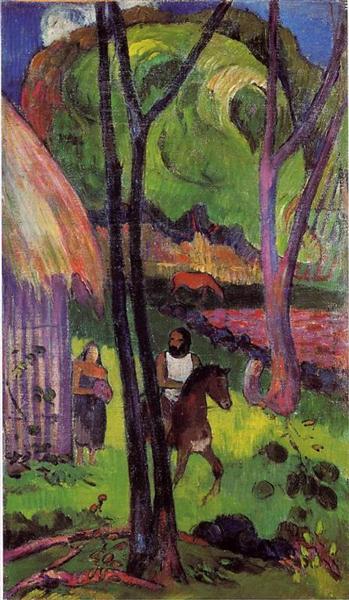Description
The painting "The rider in front of the bushing" (1892) by Paul Gauguin is inscribed within his aesthetic and spiritual search period, where the artist sought to distance himself from the impressionist currents of his time to explore a more symbolic style. In this work, Gauguin presents an austere and evocative approach, using a combination of vibrant colors and asymmetric composition that invite contemplation.
He painting It shows a rider mounted on a horse, whose figure focuses on the foreground, apparently stripped of any explicit narrative context. The proximity of the rider to the circular structure that seems to represent a bushing, provides a feeling of isolation and introspection. The figure of the man, dressed in clothes of a deep blue color, contrasts significantly with the warm tones of the background, where ocher and green predominate. This use of color not only highlights the character, but also suggests an emotional connection with the environment, since his body seems to merge with the earth, referring to a psychological depth that goes beyond literal representation.
Gauguin is known for its exploration of the Pacific cultures, but in this work, a more introspective key is perceived in the use of symbolism. The rider can be seen as a representation of the individual in a vast emotional and existential world, a recurring theme in his work that points to the search for meaning in life. This subjective experience is extended through the non -naturalistic color palette, which often uses to evoke a particular mood or a specific atmosphere.
The composition of the work is remarkable for its intentional imbalance. The figure of the rider is on the left, leaving the right side almost empty, which can be interpreted as a way of reflecting the individual's internal struggle against the unknown. This void suggests the vastness of space and, at the same time, closes the dialogue between the rider and the environment, which can be interpreted as a representation of loneliness and yearning. It also highlights Gauguin's technique to use curved lines and organic forms to give fluidity and movement to the painting, creating a feeling of dynamism that contrasts with the stillness of the character.
Another interesting facet is the relationship between the rider and the bushing, which can be seen as a symbol of the trip, not only physical, but also spiritual. The centrality of the bushing in the composition invites the viewer to turn his gaze to the rider, almost as if he were preparing for a trip that transcends the physical, in search of answers in a world that may seem endless and full of uncertainties.
The use of symbolism in "The rider in front of the bushing" echoes other Gauguin works, where the artist explores the human condition through the beauty of color and shape. Similar to his works in Tahiti, which contain elements of the mystical and the spiritual, this painting reflects a search that goes beyond mere representation, inviting the viewer to an internal dialogue about their own personal and existential journey.
In conclusion, "the rider in front of the bushing" is erected as a testimony of Gauguin's artistic development, where every color, shape and composition are intertwined to communicate a deep reflection on the human being in his search for meaning, capturing the essence of the essence of the Symbolism that the artist hugged with fervor in his latest works. Through this piece, the spectator is prompted to contemplate the complexity of human experience, in its constant struggle between being and go, between the self and the world that surrounds it.
KUADROS ©, a famous paint on your wall.
Hand-made oil painting reproductions, with the quality of professional artists and the distinctive seal of KUADROS ©.
Reproduction service paintings With a guarantee of satisfaction. If you are not completely satisfied with the replica of your painting, we refund your money 100%.

